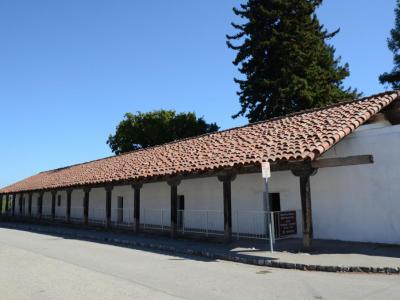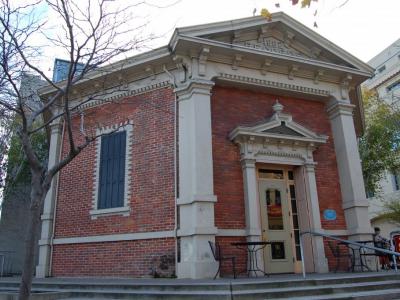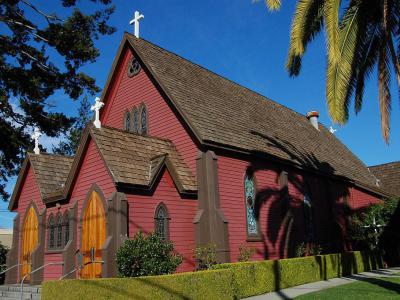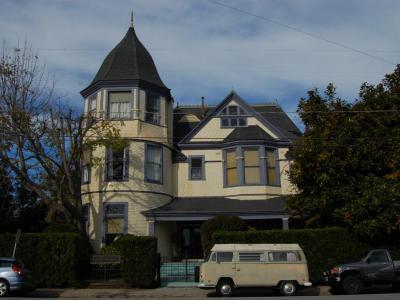
Historical Buildings Walk (Self Guided), Santa Cruz
Apart from surfboard-filled shores, Santa Cruz is also rich in history reflected in the old buildings listed on the National Register of Historic Places. While none of Santa Cruz's historic architecture sprang up overnight, a great deal of it was lost, or severely damaged, in a single go on October 17, 1989 as a result of the Loma Prieta earthquake. Still, some of the historic buildings have survived and today, thoroughly restored, define the character of downtown Santa Cruz.
Here are some of the historic spots that allow visitors a fantastic opportunity to immerse in a bygone era:
Holy Cross Church – one of the Catholic temples associated with Mission Santa Cruz, built in 1931; features a traditional Spanish garden.
Neary-Rodriguez Adobe – Santa Cruz's oldest structure, dated back circa 1810.
Octagon Building – a historic redbrick octagonal edifice, constructed in 1882.
Santa Cruz Civic Auditorium – home to the Santa Cruz Symphony and the Cabrillo Festival, opened in 1940.
Hinds House – a historic, Victorian-style edifice built in 1888-1889; the largest surviving Stick-Eastlake house in Santa Cruz County – now a historical inn.
Del Mar Theater – originally built in 1936, renowned for its Art Deco style.
Golden Gate Villa – a Queen Anne-style house from 1891; listed on the United States National Register of Historic Places since 1975.
To explore the historic part of Santa Cruz with its architectural landmarks in more detail, take this self-guided walk. Your next best thing to time travel!
Here are some of the historic spots that allow visitors a fantastic opportunity to immerse in a bygone era:
Holy Cross Church – one of the Catholic temples associated with Mission Santa Cruz, built in 1931; features a traditional Spanish garden.
Neary-Rodriguez Adobe – Santa Cruz's oldest structure, dated back circa 1810.
Octagon Building – a historic redbrick octagonal edifice, constructed in 1882.
Santa Cruz Civic Auditorium – home to the Santa Cruz Symphony and the Cabrillo Festival, opened in 1940.
Hinds House – a historic, Victorian-style edifice built in 1888-1889; the largest surviving Stick-Eastlake house in Santa Cruz County – now a historical inn.
Del Mar Theater – originally built in 1936, renowned for its Art Deco style.
Golden Gate Villa – a Queen Anne-style house from 1891; listed on the United States National Register of Historic Places since 1975.
To explore the historic part of Santa Cruz with its architectural landmarks in more detail, take this self-guided walk. Your next best thing to time travel!
How it works: Download the app "GPSmyCity: Walks in 1K+ Cities" from Apple App Store or Google Play Store to your mobile phone or tablet. The app turns your mobile device into a personal tour guide and its built-in GPS navigation functions guide you from one tour stop to next. The app works offline, so no data plan is needed when traveling abroad.
Historical Buildings Walk Map






Guide Name: Historical Buildings Walk
Guide Location: USA » Santa Cruz (See other walking tours in Santa Cruz)
Guide Type: Self-guided Walking Tour (Sightseeing)
# of Attractions: 8
Tour Duration: 2 Hour(s)
Travel Distance: 2.8 Km or 1.7 Miles
Author: karenl
Sight(s) Featured in This Guide:
Guide Location: USA » Santa Cruz (See other walking tours in Santa Cruz)
Guide Type: Self-guided Walking Tour (Sightseeing)
# of Attractions: 8
Tour Duration: 2 Hour(s)
Travel Distance: 2.8 Km or 1.7 Miles
Author: karenl
Sight(s) Featured in This Guide:
- Holy Cross Church
- Neary-Rodriguez Adobe (Oldest Building in Santa Cruz)
- Octagon Building
- Santa Cruz Civic Auditorium
- Hinds House
- Calvary Episcopal Church
- Del Mar Theater
- Golden Gate Villa
1) Holy Cross Church
Holy Cross Church is one of the Catholic churches in Santa Cruz that has a connection to Mission Santa Cruz. The parish's building was constructed in 1931 in the same style as the original church building. One of the highlights in the altar area is the tabernacle used in the original church building. The domed ceiling features colorful decorative tiles.
The church has a collection of vestments from the 18th and 19th centuries on display. These vestments have been made of silk and feature fine detailing. Colors and symbols used on these vestments correspond with the seasons of the Church Year.
One of the top highlights on the church grounds is the garden. This garden features a traditional Spanish style, complete with statuary and a fountain. The garden has a walkway and benches that encourage visitors to relax and enjoy the scenic beauty. You'll enjoy multiple opportunities to take pictures.
The church has a collection of vestments from the 18th and 19th centuries on display. These vestments have been made of silk and feature fine detailing. Colors and symbols used on these vestments correspond with the seasons of the Church Year.
One of the top highlights on the church grounds is the garden. This garden features a traditional Spanish style, complete with statuary and a fountain. The garden has a walkway and benches that encourage visitors to relax and enjoy the scenic beauty. You'll enjoy multiple opportunities to take pictures.
2) Neary-Rodriguez Adobe (Oldest Building in Santa Cruz)
The Neary-Rodriguez Adobe, nestled in Santa Cruz, stands as the oldest structure in the city, dating back to approximately 1810. It is a significant historical site within the Santa Cruz Mission State Historic Park. Originally constructed as a duplex, the adobe served dual purposes: one side accommodated the mission commander and his family, while the other housed subordinates. This layout reflects the hierarchical structure of mission life during the Spanish colonization of California.
Over time, the adobe transformed, including the addition of a second story in the mid-19th century. Originally part of the broader Santa Cruz Mission, the building's history is deeply intertwined with the early Spanish and Native American heritage of the area. The Neary and Rodriguez families, the building's namesake occupants, lived in the adobe post-1834 after the secularization of the mission, marking a shift from religious to civilian use.
The adobe has been meticulously preserved, maintaining much of its original architectural integrity. It was listed on the National Register of Historic Places in 1975, a testament to its historical and cultural significance. Visitors to the Neary-Rodriguez Adobe can explore six of its original eight rooms, experiencing the traditional stucco roofs and adobe walls that exemplify mission-era construction. The site offers a tangible connection to the past, illustrating life during a pivotal period in California's history.
Over time, the adobe transformed, including the addition of a second story in the mid-19th century. Originally part of the broader Santa Cruz Mission, the building's history is deeply intertwined with the early Spanish and Native American heritage of the area. The Neary and Rodriguez families, the building's namesake occupants, lived in the adobe post-1834 after the secularization of the mission, marking a shift from religious to civilian use.
The adobe has been meticulously preserved, maintaining much of its original architectural integrity. It was listed on the National Register of Historic Places in 1975, a testament to its historical and cultural significance. Visitors to the Neary-Rodriguez Adobe can explore six of its original eight rooms, experiencing the traditional stucco roofs and adobe walls that exemplify mission-era construction. The site offers a tangible connection to the past, illustrating life during a pivotal period in California's history.
3) Octagon Building
The Octagon Building, an iconic redbrick, octagonal structure in Santa Cruz, stands prominently on Cooper Street at the intersection with Front Street. Constructed in 1882, this historic building initially served as the County Hall of Records, positioned next to the original County Courthouse built in 1866. Its unique design was inspired by a $50 octagonal-shaped gold coin minted in San Francisco during 1851-52, with architectural plans drawn up by J. W. Newcum of Oakland.
Despite its surroundings suffering extensive damage, the Octagon Building has demonstrated remarkable resilience. In 1894, it was one of the few structures to withstand a devastating fire that destroyed many nearby buildings, including the courthouse it was built beside. It survived again in the 1989 Loma Prieta earthquake, which caused significant damage to many other historic brick buildings in the area.
The building ceased to serve as the County Hall of Records in 1968 when the records were relocated to a new County Government Center. It was then repurposed and has since played various roles in the community. On March 24, 1971, the Octagon was recognized for its historical significance and added to the National Register of Historic Places. Two years later, in 1973, it was also listed as a historic landmark by the Santa Cruz Museum of Art and History (MAH).
From 1993, the Octagon Building hosted the Museum Store for the adjacent Santa Cruz Museum of Art and History and was later transformed into a coffeehouse. Although vacant as of October 2016, the building continues to be administered by the MAH, awaiting new opportunities to serve the public and enrich Santa Cruz’s cultural landscape.
Despite its surroundings suffering extensive damage, the Octagon Building has demonstrated remarkable resilience. In 1894, it was one of the few structures to withstand a devastating fire that destroyed many nearby buildings, including the courthouse it was built beside. It survived again in the 1989 Loma Prieta earthquake, which caused significant damage to many other historic brick buildings in the area.
The building ceased to serve as the County Hall of Records in 1968 when the records were relocated to a new County Government Center. It was then repurposed and has since played various roles in the community. On March 24, 1971, the Octagon was recognized for its historical significance and added to the National Register of Historic Places. Two years later, in 1973, it was also listed as a historic landmark by the Santa Cruz Museum of Art and History (MAH).
From 1993, the Octagon Building hosted the Museum Store for the adjacent Santa Cruz Museum of Art and History and was later transformed into a coffeehouse. Although vacant as of October 2016, the building continues to be administered by the MAH, awaiting new opportunities to serve the public and enrich Santa Cruz’s cultural landscape.
4) Santa Cruz Civic Auditorium
The Santa Cruz Civic Auditorium is a notable event and convention venue located in the heart of downtown Santa Cruz, on Church Street. Since its opening in 1940, the building has been an architectural gem, blending Mission-style design with modern touches and featuring open porches on its corners and sides. Its architectural style has also been characterized as Art Deco.
Owned and operated by the City of Santa Cruz, the auditorium serves as the primary venue for the Santa Cruz County Symphony. It also hosts a diverse array of events including concerts, expos, conferences, and sporting events. A distinctive feature of the venue is the carillon, installed in 1963, adding a unique auditory element to its structure.
The venue has been part of significant cultural and social events. Notably, in 1956, it gained national attention when a rock and roll concert was halted by local police due to the "suggestive, stimulating and tantalizing motions" of the dancers. From 1966 to 1985, the auditorium was the proud host of the annual Miss California beauty pageant. The pageant's departure in 1985 followed protests and the creation of the "Myth California" counter-pageant by feminist activists Ann Simonton and Nikki Craft, marking a pivotal shift in local cultural dynamics.
In 1984, the auditorium received a significant artistic addition when artist Guillermo Wagner Granizo donated a ceramic tile mural entitled "A Gift of Appreciation to this Area," which captures imagery of past events at the venue.
Owned and operated by the City of Santa Cruz, the auditorium serves as the primary venue for the Santa Cruz County Symphony. It also hosts a diverse array of events including concerts, expos, conferences, and sporting events. A distinctive feature of the venue is the carillon, installed in 1963, adding a unique auditory element to its structure.
The venue has been part of significant cultural and social events. Notably, in 1956, it gained national attention when a rock and roll concert was halted by local police due to the "suggestive, stimulating and tantalizing motions" of the dancers. From 1966 to 1985, the auditorium was the proud host of the annual Miss California beauty pageant. The pageant's departure in 1985 followed protests and the creation of the "Myth California" counter-pageant by feminist activists Ann Simonton and Nikki Craft, marking a pivotal shift in local cultural dynamics.
In 1984, the auditorium received a significant artistic addition when artist Guillermo Wagner Granizo donated a ceramic tile mural entitled "A Gift of Appreciation to this Area," which captures imagery of past events at the venue.
5) Hinds House
The Hinds House in Santa Cruz is a notable historic building and a fine example of Victorian architecture. Constructed between 1888 and 1889 by Alfred J. Hinds and his wife Sarah, this residence is recognized as the largest surviving Stick-Eastlake house in Santa Cruz County. The architectural style was crafted by local architect John H. Williams, known for designing over sixty buildings in the area.
Alfred Hinds, born in 1845 in Chester, England, moved to the United States during his early childhood and eventually settled in Santa Cruz in 1852. An active community member, Hinds ventured into various businesses and civic activities, from owning a book and stationery shop to engaging in real estate development and participating in local governance and fraternal orders.
Tragedy struck the Hinds family in 1876 when a diphtheria epidemic claimed the lives of their four children. However, they later had three more children who survived into adulthood. Alfred Hinds passed away in 1921, and over the years, the ownership and purpose of the house shifted. By 1982, the Hinds House had been transformed into a bed and breakfast inn, now known as the Hinds Victorian Guest House, which provides weekly lodging and maintains much of its original Victorian charm.
Today, the Hinds House features original woodwork, a grand staircase with one of Santa Cruz's first electric lights installed in the 1890s, and well-preserved common rooms like the dining room, sitting room, and parlor. Located on Chestnut Street, near the heart of downtown and close to the University of California, Santa Cruz, it offers ten guest rooms, including in the attic, surrounded by significant greenery like Norfolk pines and a towering Coastal Redwood. This historic inn not only serves as a living museum of the Victorian era but also as a charming accommodation for those visiting or relocating to Santa Cruz.
Alfred Hinds, born in 1845 in Chester, England, moved to the United States during his early childhood and eventually settled in Santa Cruz in 1852. An active community member, Hinds ventured into various businesses and civic activities, from owning a book and stationery shop to engaging in real estate development and participating in local governance and fraternal orders.
Tragedy struck the Hinds family in 1876 when a diphtheria epidemic claimed the lives of their four children. However, they later had three more children who survived into adulthood. Alfred Hinds passed away in 1921, and over the years, the ownership and purpose of the house shifted. By 1982, the Hinds House had been transformed into a bed and breakfast inn, now known as the Hinds Victorian Guest House, which provides weekly lodging and maintains much of its original Victorian charm.
Today, the Hinds House features original woodwork, a grand staircase with one of Santa Cruz's first electric lights installed in the 1890s, and well-preserved common rooms like the dining room, sitting room, and parlor. Located on Chestnut Street, near the heart of downtown and close to the University of California, Santa Cruz, it offers ten guest rooms, including in the attic, surrounded by significant greenery like Norfolk pines and a towering Coastal Redwood. This historic inn not only serves as a living museum of the Victorian era but also as a charming accommodation for those visiting or relocating to Santa Cruz.
6) Calvary Episcopal Church
Calvary Episcopal Church, located at Lincoln and Center Streets in downtown Santa Cruz, serves as a historic Episcopal worship site. Established in 1864, it is celebrated for being the oldest church building in Santa Cruz County still serving its original purpose. As a significant architectural and community landmark, the church was designed by Joseph Boston and is noted for its genteel brick Gothic style, featuring smallish structures adorned with impressive stained glass from the turn of the century, and art nouveau-esque candle brackets at the end of each pew.
The mission of Calvary Church extends beyond its historical roots, focusing on spreading the word of God in Christ and engaging with the broader Santa Cruz community. Over the years, the church has expanded its outreach, establishing a strong connection with the local population through various services and programs, including a vibrant music program and day-care facilities housed within its parish compound.
Calvary Church's strategic location in a bustling downtown area adds to its appeal, surrounded by a mix of prosperous and eclectic neighborhoods, cultural offerings such as a nearby women’s bookstore, and local coffee houses that enhance the community vibe. In 2015, the church marked 150 years of ongoing worship, celebrating its enduring presence and the continued dedication of its laity.
Today, Calvary Episcopal Church remains a cornerstone of spiritual life and community service in Santa Cruz, faithfully serving its congregation and visitors alike, while maintaining its historic charm and commitment to its founding principles.
The mission of Calvary Church extends beyond its historical roots, focusing on spreading the word of God in Christ and engaging with the broader Santa Cruz community. Over the years, the church has expanded its outreach, establishing a strong connection with the local population through various services and programs, including a vibrant music program and day-care facilities housed within its parish compound.
Calvary Church's strategic location in a bustling downtown area adds to its appeal, surrounded by a mix of prosperous and eclectic neighborhoods, cultural offerings such as a nearby women’s bookstore, and local coffee houses that enhance the community vibe. In 2015, the church marked 150 years of ongoing worship, celebrating its enduring presence and the continued dedication of its laity.
Today, Calvary Episcopal Church remains a cornerstone of spiritual life and community service in Santa Cruz, faithfully serving its congregation and visitors alike, while maintaining its historic charm and commitment to its founding principles.
7) Del Mar Theater
The Del Mar Theater, situated on Pacific Avenue in Santa Cruz, is an iconic venue with a storied past and a vibrant present. Constructed in 1936 during the pinnacle of the movie palace era, the theater exemplifies the Art Deco style that defined that period. A significant restoration in 2002 modernized the theater while preserving its historical essence, enhancing it with cutting-edge sound and projection systems to ensure a premier cinematic experience.
Today, the Del Mar is operated by Landmark Theatres under the ownership of the City of Santa Cruz. It features a grand auditorium with 288 seats and two smaller theaters, each with 138 seats. This triplex arrangement allows the theater to offer a diverse array of film experiences, from the latest Hollywood blockbusters to foreign and independent films. Midnight movie screenings are a particularly popular draw, adding a unique flavor to its repertoire.
Community involvement is central to Del Mar's operations, as it opens its doors to local groups for presentations and is an active participant in the cultural life of Santa Cruz. Annually, from April 1st to November 15th, the theater is available for non-profit organizations to host film festivals and lecture series, emphasizing its role as a community hub.
The concession area of the theater is another highlight, where patrons can enjoy organic popcorn with real butter under a beautifully designed Art Deco ceiling. This space offers a variety of popular local snacks, adding to the overall enjoyment of the movie-going experience.
The Del Mar Theater remains a cherished institution in Santa Cruz, combining rich history, architectural beauty, and modern technology to create a unique and memorable cinematic experience.
Today, the Del Mar is operated by Landmark Theatres under the ownership of the City of Santa Cruz. It features a grand auditorium with 288 seats and two smaller theaters, each with 138 seats. This triplex arrangement allows the theater to offer a diverse array of film experiences, from the latest Hollywood blockbusters to foreign and independent films. Midnight movie screenings are a particularly popular draw, adding a unique flavor to its repertoire.
Community involvement is central to Del Mar's operations, as it opens its doors to local groups for presentations and is an active participant in the cultural life of Santa Cruz. Annually, from April 1st to November 15th, the theater is available for non-profit organizations to host film festivals and lecture series, emphasizing its role as a community hub.
The concession area of the theater is another highlight, where patrons can enjoy organic popcorn with real butter under a beautifully designed Art Deco ceiling. This space offers a variety of popular local snacks, adding to the overall enjoyment of the movie-going experience.
The Del Mar Theater remains a cherished institution in Santa Cruz, combining rich history, architectural beauty, and modern technology to create a unique and memorable cinematic experience.
8) Golden Gate Villa
Golden Gate Villa in Santa Cruz is a notable Queen Anne-style mansion with a rich history that dates back to its construction in 1891. Designed by architect Thomas J. Welsh from San Francisco, the villa was built as a summer residence for Major Frank McLaughlin, a prominent mining engineer and California politician. McLaughlin, who was a protégé of Thomas Edison, named the house after one of his mining ventures in Oroville.
The villa features three stories, a full basement, an attic, two full towers, and one half-tower, with the main tower once being the highest point in Santa Cruz. This architectural marvel served not only as a private residence but also as a social hub, hosting notable figures such as Theodore Roosevelt and Thomas Edison.
In the 1940s, the villa transitioned into a commercial space, operating as the Palais Monte Carlo restaurant. It changed hands several times until 1963 when it was purchased by seafood magnate William W. Durney and his wife, screenwriter Dorothy Kingsley. Eventually, the villa was sold to its current owner and was added to the United States National Register of Historic Places on July 24, 1975.
Golden Gate Villa stands as a reminder of the opulence of Beach Hill as a resort area in early Santa Cruz. The district once boasted several villas and hotels, such as the Sea Beach Hotel, but Golden Gate Villa is the sole survivor, encapsulating an era and an architectural style that have otherwise faded from memory. Today, Golden Gate Villa remains a historical landmark, echoing the legacies of its former owner and the transformative era he epitomized.
The villa features three stories, a full basement, an attic, two full towers, and one half-tower, with the main tower once being the highest point in Santa Cruz. This architectural marvel served not only as a private residence but also as a social hub, hosting notable figures such as Theodore Roosevelt and Thomas Edison.
In the 1940s, the villa transitioned into a commercial space, operating as the Palais Monte Carlo restaurant. It changed hands several times until 1963 when it was purchased by seafood magnate William W. Durney and his wife, screenwriter Dorothy Kingsley. Eventually, the villa was sold to its current owner and was added to the United States National Register of Historic Places on July 24, 1975.
Golden Gate Villa stands as a reminder of the opulence of Beach Hill as a resort area in early Santa Cruz. The district once boasted several villas and hotels, such as the Sea Beach Hotel, but Golden Gate Villa is the sole survivor, encapsulating an era and an architectural style that have otherwise faded from memory. Today, Golden Gate Villa remains a historical landmark, echoing the legacies of its former owner and the transformative era he epitomized.
Walking Tours in Santa Cruz, California
Create Your Own Walk in Santa Cruz
Creating your own self-guided walk in Santa Cruz is easy and fun. Choose the city attractions that you want to see and a walk route map will be created just for you. You can even set your hotel as the start point of the walk.
Santa Cruz Introduction Walking Tour
Santa Cruz dates back to the founding of Mission Santa Cruz, founded in 1791. The modern city's incorporation dates back to 1866, and some of the most popular industries were agriculture, lime mining, gunpowder manufacturing, and lumber.
In July 1885, three teenage Hawaiian princes took a break from their boarding school, St. Mathew's Hall in San Mateo, and came to cool off in Santa... view more
Tour Duration: 1 Hour(s)
Travel Distance: 2.8 Km or 1.7 Miles
In July 1885, three teenage Hawaiian princes took a break from their boarding school, St. Mathew's Hall in San Mateo, and came to cool off in Santa... view more
Tour Duration: 1 Hour(s)
Travel Distance: 2.8 Km or 1.7 Miles
The Most Popular Cities
/ view all









